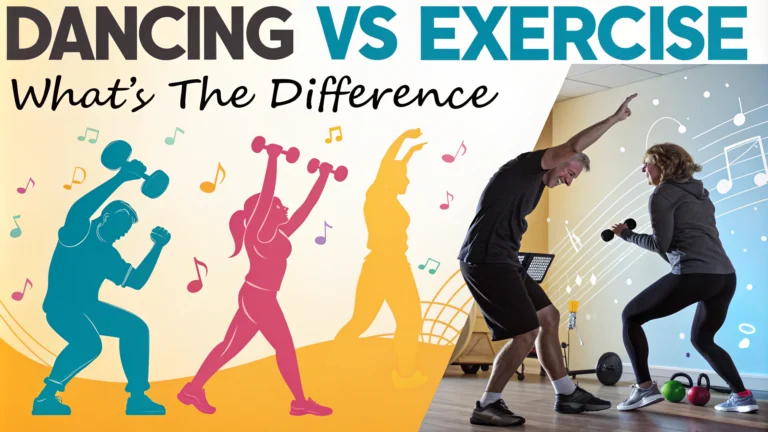Dancing and exercise share many physical benefits, but their approaches to movement and mental engagement create distinct experiences. While traditional exercise focuses on repetitive movements and specific muscle groups, dancing combines artistic expression with physical activity.
Understanding these differences helps you choose the right activity for your fitness goals and personal preferences. Both forms of movement offer unique advantages for physical health, mental well-being, and social connection.
Key Physical and Mental Benefits
Dancing provides unique benefits including:
- Enhanced coordination and balance
- Improved spatial awareness
- Better memory through learning choreography
- Social connection and emotional expression
Exercise typically offers:
- Structured muscle development
- Measurable fitness progress
- Specific target area focus
- Controlled intensity levels
Comparing Calorie Burn and Intensity
| Activity (30 minutes) | Calories Burned* |
|---|---|
| Ballroom Dancing | 150-200 |
| Jogging | 240-300 |
| Zumba | 300-400 |
| Weight Training | 140-180 |
*Estimates based on 150-pound person
Which Activity Suits Your Goals?
Choose dancing if you want:
- Creative expression while staying active
- Social interaction during workouts
- Mental stimulation with physical movement
Pick traditional exercise if you prefer:
- Structured fitness routines
- Specific strength or endurance goals
- Measurable progress tracking
Making Dance and Exercise Work Together
Combining dance with exercise creates a more balanced and enjoyable fitness routine. Learning where each activity shines helps you build a workout plan that suits your lifestyle.
Adding Dance Elements to Your Workout
Transform basic exercises into dance-inspired movements to boost engagement and fun.
- Play upbeat music during strength training
- Add rhythmic movements between sets
- Include dance-inspired warm-ups
- Try dance cardio intervals
Dance-Exercise Fusion Workouts
Several workout styles blend dance and traditional exercise effectively.
| Workout Type | Benefits |
|---|---|
| Barre | Ballet-inspired strength and flexibility |
| Dance HIIT | High-intensity cardio with choreography |
| Cardio Dance | Aerobic fitness with rhythm |
Sample Weekly Schedule
Balance both activities throughout your week for optimal results.
- Monday: Strength training + dance cooldown
- Tuesday: Dance class
- Wednesday: HIIT workout
- Thursday: Dance cardio
- Friday: Weight training + dance warmup
- Weekend: Free dance or rest
Creating Your Own Movement Style
Develop a personalized approach that matches your fitness level and interests.
- Start with basic movements you enjoy
- Mix dance styles with familiar exercises
- Track which combinations feel natural
- Adjust intensity based on energy levels
“The best workout routine is one that keeps you coming back for more.”
Remember to listen to your body and adjust activities as needed. Both dance and exercise can be modified to match your current fitness level and goals.
Start with short sessions combining both elements, then gradually increase duration and complexity as you build confidence and strength.
Dancing vs Exercise FAQs
Q: What burns more calories – 30 minutes of dancing or running?
A: Calorie burn varies by intensity and style. High-impact dancing burns 200-400 calories per 30 minutes, while running typically burns 280-520 calories. Ballroom dancing burns fewer calories (150-220), making running generally more effective for calorie burn.
Q: Is dancing considered cardio exercise?
A: Yes, dancing qualifies as cardiovascular exercise when performed continuously for at least 10 minutes. It elevates heart rate and improves:
- Cardiovascular endurance
- Stamina
- Oxygen utilization
Q: Which is better for weight loss – Zumba or traditional gym workouts?
A: Both are effective, but their benefits differ:
| Zumba | Traditional Gym |
|---|---|
| 400-600 calories/hour | 300-800 calories/hour |
| Higher enjoyment factor | More targeted training |
| Better adherence rates | Precise progress tracking |
Q: Can dancing replace strength training?
A: Dancing alone cannot fully replace strength training. While it builds some muscle endurance, it typically doesn’t provide enough resistance for significant muscle growth or strength gains.
Q: Which style of dance is most similar to HIIT workouts?
A: Hip-hop and cardio dance classes most closely resemble HIIT workouts, featuring burst of intense movement followed by slower sequences.
Q: Does ballroom dancing count as moderate exercise?
A: Yes, ballroom dancing qualifies as moderate-intensity exercise, burning 150-220 calories per hour and improving balance, coordination, and social interaction.
Q: What are the unique mental health benefits of dancing vs regular exercise?
A: Dancing offers additional mental benefits:
- Enhanced creativity
- Better spatial awareness
- Improved social connections
- Greater cognitive stimulation
Q: Is dance better than yoga for flexibility?
A: Yoga typically provides better flexibility improvements than dance, as it includes focused stretching and longer hold times. However, dance improves dynamic flexibility and range of motion.
Q: Which burns more fat – dance cardio or spinning?
A: Spinning typically burns more fat, averaging 400-600 calories per 45-minute session compared to dance cardio’s 350-450 calories. However, dance provides additional benefits like coordination and agility.
Q: Are dance workouts suitable for beginners over 50?
A: Yes, many dance styles are appropriate for older beginners, particularly:
- Gentle ballet
- Low-impact jazz
- Social ballroom dancing
- Chair dancing
Q: Which is better for posture – Pilates or ballet-inspired workouts?
A: Both improve posture, but Pilates typically provides more targeted core strengthening and spine alignment. Ballet-inspired workouts add grace and movement quality to posture improvement.



















